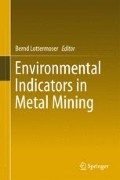Abstract
Successful rehabilitation of mine sites requires a solid knowledge of waste and mine soil properties. In particular, there is a need for a predictive test that allows forecasting of risks to plant growth on contaminated mine soils and waste repositories. In this contribution, a new plant bioaccessibility test is described that meets this need. The methodology for the new test oxidizes the sample with hydrogen peroxide and then extracts the solubilized metals and metalloids from the sample using 1 M ammonium acetate solution. The test is based on aspects of two established tests: (1) the sequential NAG test, which is suitable for sulfidic samples but does not determine metals and metalloids; and (2) the BCR® extraction, which gives information on the geochemical fractionation of these elements but is not suitable for highly sulfidic samples. Learnings from the method development, a stepwise test protocol and a simplified flow diagram for the test are presented. The proposed new plant bioaccessibility test represents a predictive tool that allows forecasting of metal fractions that may become available to plants upon colonization of sulfidic soils and wastes at mine sites.
Access this chapter
Tax calculation will be finalised at checkout
Purchases are for personal use only
References
Amos RT, Blowes DW, Bailey BL, Sego DC, Smith L, Ritchie AIM (2015) Waste-rock hydrogeology and geochemistry. Appl Geochem 57:140–156
Bryan GW, Langston W (1992) Bioavailability, accumulation and effects of heavy metals in sediments with special reference to United Kingdon estuaries: a review. Environ Pollut 76:89–131
Cave MR, Wragg J, Palumbo B, Klinck BA (2003) Measurement of the bioaccessibility of arsenic in UK soils, Environment Agency and the British Geological Survey
Gonzaga MIS, Ma LQ, Pacheco EP, dos Santos WM (2012) Predicting arsenic bioavailability to hyperaccumulator Pteris Vittata in arsenic-contaminated soils. Int J Phytorem 14:939–949
Houba VJG, Lexmond TM, Novozamsky I, van der Lee JJ (1996) State of the art and future developments in soil analysis for bioavailability assessment. Sci Total Environ 178:21–28
Lacal J, da Silva MP, Garcı́a R, Sevilla MT, Procopio JR, Hernandez L (2003) Study of fractionation and potential mobility of metal in sludge from pyrite mining and affected river sediments: changes in mobility over time and use of artificial ageing as a tool in environmental impact assessment. Environ Pollut 124: 291–305
Lottermoser BG, Glass HJ, Page CN (2011) Sustainable natural remediation of abandoned tailings by metal-excluding heather (Calluna vulgaris) and gorse (Ulex europaeus), Carnon Valley, Cornwall, UK. Ecol Eng 37:1249–1253
Parbhakar-Fox A, Lottermoser BG (2015) A critical review of acid rock drainage processes and practices. Miner Eng 82:107–124
Pérez-López R, Álvarez-Valero AM, Nieto JM, Sáez R, Matos JX (2008) Use of sequential extraction procedure for assessing the environmental impact at regional scale of the São Domingos Mine (Iberian Pyrite Belt). Appl Geochem 23:3452–3463
Pueyo M, López-Sánchez JF, Rauret G (2004) Assessment of CaCl2, NaNO3 and NH4NO3 extraction procedures for the study of Cd, Cu, Pb and Zn extractability in contaminated soils. Anal Chimica Acta 504:217–226
Quispe D, Pérez-López R, Acero P, Ayora C, Nieto JM, Tucoulou R (2013) Formation of a hardpan in the co-disposal of fly ash and sulfide mine tailings and its influence on the gen-eration of acid mine drainage. Chem Geol 355:45–55
Rao C, Sahuquillo A, Sanchez JL (2008) A review of the different methods applied in environmental geochemistry for single and sequential extraction of trace elements in soils and related materials. Water Air Soil Pollut 189:291–333
Rauret G, Lopez-Sanchez JF, Sahuquillo A, Rubio R, Davidson C, Ure A, Quevauviller P (1999) Improvement of the BCR® three step sequential extraction procedure prior to the certification of new sediment and soil reference materials. J Environ Monit 1:57–61
Ruby MV, Davis A, Schoof R, Eberle S, Sellstone CM (1996) Estimation of lead and arsenic bioavailability using a physiologically based extraction test. Environ Sci Technol 30:422–430
Schaider LA, Senn DB, Brabander DJ, McCarthy KD, Shine JP (2007) Characterization of zinc, lead, and cadmium in mine waste: implications for transport, exposure, and bioavailability. Environ Sci Technol 41:4164–4171
Semple KT, Doick KJ, Jones KC, Burauel P, Craven A, Harms H (2004) Defining bioavailability and bioaccessibility of contaminated soil and sediment is complicated. Environ Sci Technol 38:228A–231A
Smart R, Skinner WM, Levay G, Gerson AR, Thomas JE, Sobieraj H, Schumann R, Weisener C, Weber P, Miller S, Stewart WA (2002) ARD test handbook: Project P387, a prediction and kinetic control of acid mine drainage. AMIRA, International Ltd, Ian Wark Research Institute, Melbourne, Australia
Sracek O, Mihaljevič M, Kříbek B, Majer V, Filip J, Vaněk A, Mapani B (2014) Geochemistry of mine tailings and behavior of arsenic at Kombat, northeastern Namibia. Environ Monit Assess 186:4891–4903
Templeton DM, Ariese F, Cornelis R, Danielsson LG, Muntau H, van Leeuwen HP, Lobinski R (2000) Guidelines for terms related to chemical speciation and fractionation of elements. Definitions, structural aspects, and methodological approaches (IUPAC Recommendations 2000). Pure Appl Chem 72:1453–1470
Tessier A, Campbell PGC, Bisson M (1979) Sequential extraction procedure for the speciation of particulate trace-metals. Anal Chem 51:844–851
Author information
Authors and Affiliations
Corresponding author
Editor information
Editors and Affiliations
Rights and permissions
Copyright information
© 2017 Springer International Publishing Switzerland
About this chapter
Cite this chapter
van Veen, E.M., Lottermoser, B., Noble, T.L. (2017). Prediction of Plant Metal Bioaccessibility in Mineralized and Sulfidic Rocks. In: Lottermoser, B. (eds) Environmental Indicators in Metal Mining. Springer, Cham. https://doi.org/10.1007/978-3-319-42731-7_21
Download citation
DOI: https://doi.org/10.1007/978-3-319-42731-7_21
Published:
Publisher Name: Springer, Cham
Print ISBN: 978-3-319-42729-4
Online ISBN: 978-3-319-42731-7
eBook Packages: Earth and Environmental ScienceEarth and Environmental Science (R0)

